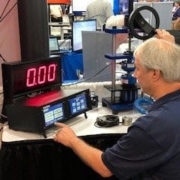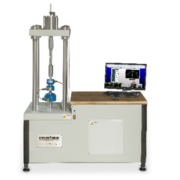Interface Engineered Solutions for Lifting Webinar Recap
 Everything from mechanical engineering designs, equipment materials, and the sensors used in lifting machinery is changing the concept of lifting today. Interface experts Keith Skidmore and Ken Bishop explore types of measurement products, applications, technical considerations, and tips for lifting use cases in the Interface recorded webinar Engineered Solutions for Lifting.
Everything from mechanical engineering designs, equipment materials, and the sensors used in lifting machinery is changing the concept of lifting today. Interface experts Keith Skidmore and Ken Bishop explore types of measurement products, applications, technical considerations, and tips for lifting use cases in the Interface recorded webinar Engineered Solutions for Lifting.
Sensors are central in lifting equipment to maintain safety, quality, compliance, and efficiency. Interface provides a useful product selection online resource for lifting applications. Go to the Lifting Solutions Guide.
Interface load cells can help prevent accidents by providing real-time feedback on the weight of the lifted load. The measurement data helps ensure the lifting machinery is not overloaded or unbalanced, leading to structural failure, tipping over, or injury. Sensor technologies improve quality control by ensuring products are lifted to the correct specifications.
Interface LowProfile Load Cells, Load Pins, Load Shackles, and Tension Links improve efficiency by automating the lifting process. For example, load cells can control the speed and movement of a lifting mechanism, ensuring that the load is lifted safely and efficiently. These measurement sensors can reduce costs by minimizing damage to equipment and products. By preventing overloads and ensuring that loads are lifted safely, load cell devices can extend the lifespan of equipment and prevent costly accidents.
In many industries, regulations require load cells for lifting applications to ensure compliance and overload protection. For example, the Occupational Safety and Health Administration (OSHA) requires the use of load cells in many lifting applications for monitoring and reporting.
Automation of lifting is on the rise. Using robotics and component activation is commonly designed into new equipment and retrofitting existing hardware. These features also provide valuable operating safety and alarm systems based on key measurements. Modernizing equipment to meet today’s and future use cases is important to operators and manufacturers of lifting equipment. This includes utilizing wireless components and using cloud-based data (IoT).
Lifting sensors are more commonly found in settings with high-temperature variances and exposure to extreme environmental conditions. The measurement solutions must withstand these variances while providing continuous monitoring capabilities. Today’s use cases require smaller load cells, like our beam load cells, while not sacrificing precision measurement.
Interface products are used for all types of lifting equipment, apparatus, and machines, including:
 All Purpose Cranes
All Purpose Cranes- Patient Lifts and Medical Equipment
- Drones with Lift and Carry Capabilities
- Aircraft Lifts and Rigging
- Lifting Gantry Systems and Mobile Gantry Cranes
- Jib Cranes
- Engine and Floor Cranes
- Scaffold Runway Systems
- Venue and Entertainment AV Equipment
- Rigging Equipment
- Pallet Movers
- Elevators
- Loaders and Bulldozers
During the webinar, Interface experts shared tips and best practices. Here is a quick summary of tips for lifting use cases.
Top Measurement Tips for Lifting Use Cases
TIP #1 Select the right force sensor. Factors to consider when selecting a force sensor include the maximum force it can measure, accuracy, weight, dimensions, and environmental conditions for use.
TIP #2 Proper installation will define your application’s success. It is important to install the force sensor correctly to ensure accurate measurements.
TIP #3 Calibrate the force sensor regularly, preferably once a year. Regularly run calibration-grade tests if the load cell is embedded into the lifting device.
TIP #4 Based on each use case, instrumentation can make all the difference in your program. For example, a data acquisition system collects force data to monitor the lifting process, identify potential problems, and generate reports.
TIP #5 Design the lifting system with safety in mind. Force measurement can improve the safety of lifting systems by preventing overloading, detecting imbalances in the load, and monitoring the condition of the lifting equipment.
Tune into the webinar to hear Keith Skidmore and Ken Bishop detail best practices, key considerations to identify stable and unstable lifting, and a thorough review of industry applications using Interface products.
Lifting Applications
Crane Capacity Verification
A customer wants to verify that their crane is strong enough to safely lift a heavy load at its rated maximum load capacity. A wireless solution is needed to avoid long cables and to have a faster installation time. Interface’s Model WTSATL Lightweight Wireless Tension Link Load Cell can measure the load’s maximum capacity. The WTS-RM1 Wireless Relay Output Receiver Modules can also trigger an alarm that can be set when the maximum capacity of weight/force has been reached. The data is transmitted and can be reviewed with the WTS-BS-1-HS Wireless Handheld Display or on the customer’s PC.
Gantry Crane Wireless Lifting for Heavy Containers
Gantry cranes are used for mobile and lifting applications in industrial and construction. A weighing system is needed to see if the gantry crane can lift heavy containers or loads, preventing crane failure or accidents. Interface’s WTSLP Wireless Stainless Steel Load Pins can be installed into the corners of the lifting mechanism of the gantry crane, where heavy-loaded containers are lifted and moved. The force results are then transmitted to the WTS-BS-1-HS Wireless Handheld Display for Single Transmitters and a connected computer using the WTS-BS-6 Wireless Telemetry Dongle Base Station.
Patient Lifting Device
In the medical field, sometimes it is necessary to weigh or transfer patients who are disabled and cannot walk. A Hoyer lift is used to move patients around. A manufacturer would like a force system to weigh disabled patients and see the maximum weight it can hold. Interface’s WTS 1200 Standard Precision LowProfile® Wireless Load Cell is attached to the top of the Hoyer lift. The force results are wirelessly transmitted to the medical laptop through the WTS-BS-6 Wireless Telemetry Dongle Base Station.
Find additional productions and solutions in our Lifting Solutions Overview.
Lifting Solutions Brochure







